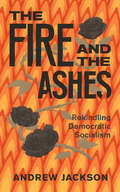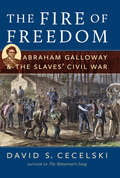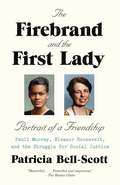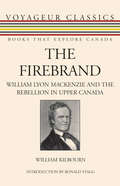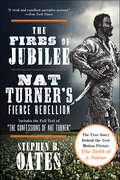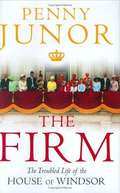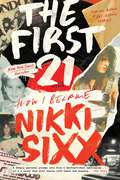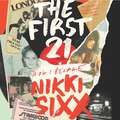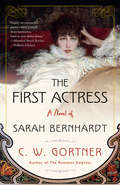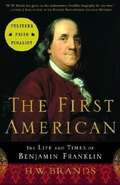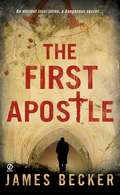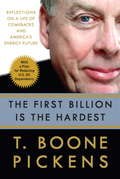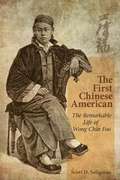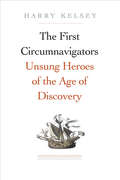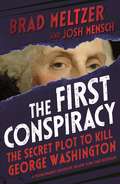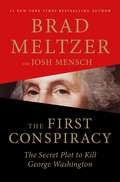- Table View
- List View
The Fire and the Ashes: Rekindling Democratic Socialism
by Andrew JacksonIn The Fire and the Ashes, long-time union economist and policy analyst Andrew Jackson looks back on a fascinating career in the labour movement, the NDP, and left politics, combining keen historical analysis with a political manifesto for today. As one of the few trade union economists in Canada, Jackson brings a unique insider perspective and decades of experience to bear on his critical reflections on the history and changing fortunes of the NDP, the failures of neoliberalism, and the waning and recent renewal of the democratic socialist tradition. What plays out is a battle of ideas fought by Jackson and the wider left—one meant to rekindle both political veterans and a new generation of activists who believe that a true democracy cannot exist with great inequalities of wealth and political power, and that social ownership and public investment must be brought squarely into the mainstream.
The Fire of Freedom
by David S. CecelskiAbraham H. Galloway (1837-1870) was a fiery young slave rebel, radical abolitionist, and Union spy who rose out of bondage to become one of the most significant and stirring black leaders in the South during the Civil War. Throughout his brief, mercurial life, Galloway fought against slavery and injustice. He risked his life behind enemy lines, recruited black soldiers for the North, and fought racism in the Union army's ranks. He also stood at the forefront of an African American political movement that flourished in the Union-occupied parts of North Carolina, even leading a historic delegation of black southerners to the White House to meet with President Lincoln and to demand the full rights of citizenship. He later became one of the first black men elected to the North Carolina legislature. Long hidden from history, Galloway's story reveals a war unfamiliar to most of us. As David Cecelski writes, "Galloway's Civil War was a slave insurgency, a war of liberation that was the culmination of generations of perseverance and faith." This riveting portrait illuminates Galloway's life and deepens our insight into the Civil War and Reconstruction as experienced by African Americans in the South.
The Fire of Stars: The Life and Brilliance of the Woman Who Discovered What Stars Are Made Of
by Kirsten W. LarsonA poetic picture book celebrating the life and scientific discoveries of the groundbreaking astronomer Cecilia Payne!Astronomer and astrophysicist Cecilia Payne was the first person to discover what burns at the heart of stars. But she didn't start out as the groundbreaking scientist she would eventually become. She started out as a girl full of curiosity, hoping one day to unlock the mysteries of the universe. With lyrical, evocative text by Kirsten W. Larson and extraordinary illustrations by award-winning illustrator Katherine Roy, this moving biography powerfully parallels the kindling of Cecilia Payne's own curiosity and her scientific career with the process of a star's birth, from mere possibility in an expanse of space to an eventual, breathtaking explosion of light.WOMEN IN STEM CAN CHANGE HISTORY: With women making up less than 30 percent of the science and engineering workforce, supporting young girls who are interested in STEM fields is more important than ever! This picture book tells the story of Cecilia Payne, a trailblazing female astronomer and role model for young girls to relate to and see themselves in, from even the youngest age.LOOK TO THE STARS: Any reader or stargazer who feels dazzled by the striking night sky will be enchanted by this true story of discovery and invention, as Cecilia's contributions to science prompt us to wonder: What else is out there?BEAUTIFUL, INSPIRING GIFT: With compelling visual storytelling and an inspiring role model for aspiring astronomers, scientists, and engineers (and for young girls in particular), this stellar biography makes a great choice for any giving moment, from birthdays to celebrations to the holidays.Perfect for:Parents, teachers, and librarians looking to instill curiosity and encourage scientific explorationLovers of astronomy, stargazing, space travel, and outer spaceAnyone seeking narrative nonfiction and biography books about women in STEM for the classroom or choice readingGift-givers looking for a unique true story to delight and inspire girls and boysFans of Hidden Figures, Rad American Women A-Z, and I Am Malala
The Firebrand and the First Lady: Pauli Murray, Eleanor Roosevelt, and the Struggle for Social Justice
by Patricia Bell-ScottA groundbreaking book—two decades in the works—that tells the story of how a brilliant writer-turned-activist, granddaughter of a mulatto slave, and the first lady of the United States, whose ancestry gave her membership in the Daughters of the American Revolution, forged an enduring friendship that changed each of their lives and helped to alter the course of race and racism in America. <P><P> Pauli Murray first saw Eleanor Roosevelt in 1933, at the height of the Depression, at a government-sponsored, two-hundred-acre camp for unemployed women where Murray was living, something the first lady had pushed her husband to set up in her effort to do what she could for working women and the poor. The first lady appeared one day unannounced, behind the wheel of her car, her secretary and a Secret Service agent her passengers. To Murray, then aged twenty-three, Roosevelt’s self-assurance was a symbol of women’s independence, a symbol that endured throughout Murray’s life. <P> Five years later, Pauli Murray, a twenty-eight-year-old aspiring writer, wrote a letter to Franklin and Eleanor Roosevelt protesting racial segregation in the South. The president’s staff forwarded Murray’s letter to the federal Office of Education. The first lady wrote back.<P> Murray’s letter was prompted by a speech the president had given at the University of North Carolina, Chapel Hill, praising the school for its commitment to social progress. Pauli Murray had been denied admission to the Chapel Hill graduate school because of her race. <P> She wrote in her letter of 1938:<P> “Does it mean that Negro students in the South will be allowed to sit down with white students and study a problem which is fundamental and mutual to both groups? Does it mean that the University of North Carolina is ready to open its doors to Negro students... ? Or does it mean, that everything you said has no meaning for us as Negroes, that again we are to be set aside and passed over... ?”<P> Eleanor Roosevelt wrote to Murray: “I have read the copy of the letter you sent me and I understand perfectly, but great changes come slowly... The South is changing, but don’t push too fast.”<P> So began a friendship between Pauli Murray (poet, intellectual rebel, principal strategist in the fight to preserve Title VII of the 1964 Civil Rights Act, cofounder of the National Organization for Women, and the first African American female Episcopal priest) and Eleanor Roosevelt (first lady of the United States, later first chair of the United Nations Commission on Human Rights, and chair of the President’s Commission on the Status of Women) that would last for a quarter of a century.<P> Drawing on letters, journals, diaries, published and unpublished manuscripts, and interviews, Patricia Bell-Scott gives us the first close-up portrait of this evolving friendship and how it was sustained over time, what each gave to the other, and how their friendship changed the cause of American social justice.
The Firebrand and the First Lady: Pauli Murray, Eleanor Roosevelt, and the Struggle for Social Justice
by Patricia Bell-ScottLonglisted for the National Book AwardA groundbreaking book—two decades in the works—that tells the story of how a brilliant writer-turned-activist, granddaughter of a mulatto slave, and the first lady of the United States, whose ancestry gave her membership in the Daughters of the American Revolution, forged an enduring friendship that changed each of their lives and helped to alter the course of race and racism in America. Pauli Murray first saw Eleanor Roosevelt in 1933, at the height of the Depression, at a government-sponsored, two-hundred-acre camp for unemployed women where Murray was living, something the first lady had pushed her husband to set up in her effort to do what she could for working women and the poor. The first lady appeared one day unannounced, behind the wheel of her car, her secretary and a Secret Service agent her passengers. To Murray, then aged twenty-three, Roosevelt’s self-assurance was a symbol of women’s independence, a symbol that endured throughout Murray’s life. Five years later, Pauli Murray, a twenty-eight-year-old aspiring writer, wrote a letter to Franklin and Eleanor Roosevelt protesting racial segregation in the South. The president’s staff forwarded Murray’s letter to the federal Office of Education. The first lady wrote back.Murray’s letter was prompted by a speech the president had given at the University of North Carolina, Chapel Hill, praising the school for its commitment to social progress. Pauli Murray had been denied admission to the Chapel Hill graduate school because of her race. She wrote in her letter of 1938: “Does it mean that Negro students in the South will be allowed to sit down with white students and study a problem which is fundamental and mutual to both groups? Does it mean that the University of North Carolina is ready to open its doors to Negro students . . . ? Or does it mean, that everything you said has no meaning for us as Negroes, that again we are to be set aside and passed over . . . ?”Eleanor Roosevelt wrote to Murray: “I have read the copy of the letter you sent me and I understand perfectly, but great changes come slowly . . . The South is changing, but don’t push too fast.” So began a friendship between Pauli Murray (poet, intellectual rebel, principal strategist in the fight to preserve Title VII of the 1964 Civil Rights Act, cofounder of the National Organization for Women, and the first African American female Episcopal priest) and Eleanor Roosevelt (first lady of the United States, later first chair of the United Nations Commission on Human Rights, and chair of the President’s Commission on the Status of Women) that would last for a quarter of a century.Drawing on letters, journals, diaries, published and unpublished manuscripts, and interviews, Patricia Bell-Scott gives us the first close-up portrait of this evolving friendship and how it was sustained over time, what each gave to the other, and how their friendship changed the cause of American social justice.From the Hardcover edition.
The Firebrand and the First Lady: Pauli Murray, Eleanor Roosevelt, and the Struggle for Social Justice
by Patricia Bell-ScottLonglisted for the National Book AwardA groundbreaking book—two decades in the works—that tells the story of how a brilliant writer-turned-activist, granddaughter of a mulatto slave, and the first lady of the United States, whose ancestry gave her membership in the Daughters of the American Revolution, forged an enduring friendship that changed each of their lives and helped to alter the course of race and racism in America. Pauli Murray first saw Eleanor Roosevelt in 1933, at the height of the Depression, at a government-sponsored, two-hundred-acre camp for unemployed women where Murray was living, something the first lady had pushed her husband to set up in her effort to do what she could for working women and the poor. The first lady appeared one day unannounced, behind the wheel of her car, her secretary and a Secret Service agent her passengers. To Murray, then aged twenty-three, Roosevelt’s self-assurance was a symbol of women’s independence, a symbol that endured throughout Murray’s life. Five years later, Pauli Murray, a twenty-eight-year-old aspiring writer, wrote a letter to Franklin and Eleanor Roosevelt protesting racial segregation in the South. The president’s staff forwarded Murray’s letter to the federal Office of Education. The first lady wrote back.Murray’s letter was prompted by a speech the president had given at the University of North Carolina, Chapel Hill, praising the school for its commitment to social progress. Pauli Murray had been denied admission to the Chapel Hill graduate school because of her race. She wrote in her letter of 1938: “Does it mean that Negro students in the South will be allowed to sit down with white students and study a problem which is fundamental and mutual to both groups? Does it mean that the University of North Carolina is ready to open its doors to Negro students . . . ? Or does it mean, that everything you said has no meaning for us as Negroes, that again we are to be set aside and passed over . . . ?”Eleanor Roosevelt wrote to Murray: “I have read the copy of the letter you sent me and I understand perfectly, but great changes come slowly . . . The South is changing, but don’t push too fast.” So began a friendship between Pauli Murray (poet, intellectual rebel, principal strategist in the fight to preserve Title VII of the 1964 Civil Rights Act, cofounder of the National Organization for Women, and the first African American female Episcopal priest) and Eleanor Roosevelt (first lady of the United States, later first chair of the United Nations Commission on Human Rights, and chair of the President’s Commission on the Status of Women) that would last for a quarter of a century.Drawing on letters, journals, diaries, published and unpublished manuscripts, and interviews, Patricia Bell-Scott gives us the first close-up portrait of this evolving friendship and how it was sustained over time, what each gave to the other, and how their friendship changed the cause of American social justice.From the Hardcover edition.
The Firebrand: William Lyon Mackenzie and the Rebellion in Upper Canada
by William Kilbourn Ronald StaggIn The Firebrand, William Kilbourn brings to life the rebel Canadian hero William Lyon Mackenzie. A skilled historian and an entertaining writer, Kilbourn reveals Mackenzie’s complex character: able political editor, shrewd recorder of his times, efficient first mayor of Toronto, and gadfly of the House of Assembly. Kilbourn vividly recreates the ill-fated Mackenzie-led march on Toronto during the Upper Canada Rebellion of 1837, an uprising of brave but comical farmers unprepared to meet musket and cannon, and deftly portrays the rebellion’s aftermath and Mackenzies subsequent escape and exile. A reprint of William Mackenzie’s own account of the Upper Canada Rebellion is featured. This touching, frequently hilarious book was originally published by Clarke, Irwin in 1956 and remained in print through numerous reprintings and editions for several decades, garnering praise such as "The Firebrand is a major step on the path to nationhood" (Globe and Mail).
The Fires of Jubilee: Nat Turner's Fierce Rebellion
by Stephen B. Oates“A penetrating reconstruction of the most disturbing and crucial slave uprising in America’s history”—with the full text of The Confessions of Nat Turner (New York Times).In August of 1831, the enslaved carpenter and preacher Nat Turner led an anti-slavery uprising in Virginia. It lasted several days before state militias captured Turner and put him on trial. Before he was executed, Turner recounted the unbearable conditions he endured and how he secretly built support for his cause over many years. Turner’s Rebellion, and the savage reprisals that followed, shattered longstanding myths of the contented slave and the benign master.Turner’s story and tactics also inspired the abolitionist movement, intensifying the forces of change that would plunge America into Civil War. Stephen B. Oates, the celebrated biographer of Abraham Lincoln and Martin Luther King, Jr., presents a gripping and insightful narrative of the rebellion—the complex, gifted, and driven man who led it, the social conditions that produced it, and the legacy it left. The Fires of Jubilee is a classic wok of American history. This new edition includes the text of the original 1831 court document "The Confessions of Nat Turner."
The Firm: The Troubled Life of the House of Windsor
by Penny JunorHowever you look at it, the royal family is a big business, though one with more ups and downs than the stock market. Prince Philip calls it "The Firm," and all the royal executives and their powerful associates are supposed to make every effort to avoid even a hint of scandal that could diminish the reputation of the family business.
The First 21: How I Became Nikki Sixx
by Nikki SixxRock-and-roll icon and three-time bestselling author Nikki Sixx tells his origin story: how Frank Feranna became Nikki Sixx, chronicling his fascinating journey from irrepressible Idaho farmboy to the man who formed the revolutionary rock group Mötley Crüe. <P><P> Nikki Sixx is one of the most respected, recognizable, and entrepreneurial icons in the music industry. As the founder of Mötley Crüe, who is now in his twenty-first year of sobriety, Sixx is incredibly passionate about his craft and wonderfully open about his life in rock and roll, and as a person of the world. Born Franklin Carlton Feranna on December 11, 1958, young Frankie was abandoned by his father and partly raised by his mother, a woman who was ahead of her time but deeply troubled. Frankie ended up living with his grandparents, bouncing from farm to farm and state to state. He was an all-American kid—hunting, fishing, chasing girls, and playing football—but underneath it all, there was a burning desire for more, and that more was music. He eventually took a Greyhound bound for Hollywood. <P><P> In Los Angeles, Frank lived with his aunt and his uncle—the president of Capitol Records—for a short time. But there was no easy path to the top. He was soon on his own. There were dead-end jobs: dipping circuit boards, clerking at liquor and record stores, selling used light bulbs, and hustling to survive. But at night, Frank honed his craft, joining Sister, a band formed by fellow hard-rock veteran Blackie Lawless, and formed a group of his own: London, the precursor of Mötley Crüe. <P><P> Turning down an offer to join Randy Rhoads’s band, Frank changed his name to Nikki London, Nikki Nine, and, finally, Nikki Sixx. Like Huck Finn with a stolen guitar, he had a vision: a group that combined punk, glam, and hard rock into the biggest, most theatrical and irresistible package the world had ever seen. With hard work, passion, and some luck, the vision manifested in reality—and this is a profound true story finding identity, of how Frank Feranna became Nikki Sixx. It's also a road map to the ways you can overcome anything, and achieve all of your goals, if only you put your mind to it. <P><P><b>A New York Times Best Seller</b>
The First 21: The New York Times Bestseller
by Nikki SixxNikki Sixx is one of the most respected, recognizable, and entrepreneurial icons in the music industry. As the founder of Mötley Crüe who is now in his twenty-first year of sobriety, Sixx is incredibly passionate about his craft and wonderfully open about his life in rock and roll, and as a person of the world.Born Franklin Carlton Feranna on December 11, 1958, young Frankie was abandoned by his father and partly raised by his mother, a woman who was ahead of her time in some ways and deeply troubled in others. Frankie ended up living with his grandparents, bouncing from farm to farm and state to state. He was an all-American kid-hunting, fishing, chasing girls, and playing football-but underneath it all, there was a burning desire for more, and that more was music. He eventually took a Greyhound bound for Hollywood.In Los Angeles, Frank lived with his aunt and his uncle-the president of Capitol Records. But there was no short path to the top. He was soon on his own. There were dead-end jobs: dipping circuit boards, clerking at liquor and record stores, selling used light bulbs, and hustling to survive. But at night, Frank honed his craft, joining Sister, a band formed by fellow hard-rock veteran Blackie Lawless, and formed a group of his own: London, the precursor of Mötley Crüe. Turning down an offer to join Randy Rhoads' band, Frank changed his name to Nikki London, Nikki Nine, and, finally, Nikki Sixx. Like Huck Finn with a stolen guitar, he had a vision: a group that combined punk, glam, and hard rock into the biggest, most theatrical and irresistible package the world had ever seen. With hard work, passion, and some luck, the vision manifested in reality - and this is a profound true story finding identity, of how Frank Feranna became Nikki Sixx. And it's a road map to the ways you can overcome anything, and achieve all of your goals, if only you put your mind to it.
The First 21: The New York Times Bestseller
by Nikki SixxThe New York Times bestsellerNikki Sixx is one of the most respected, recognizable, and entrepreneurial icons in the music industry. As the founder of Mötley Crüe who is now in his twenty-first year of sobriety, Sixx is incredibly passionate about his craft and wonderfully open about his life in rock and roll, and as a person of the world.Born Franklin Carlton Feranna on December 11, 1958, young Frankie was abandoned by his father and partly raised by his mother, a woman who was ahead of her time in some ways and deeply troubled in others. Frankie ended up living with his grandparents, bouncing from farm to farm and state to state. He was an all-American kid-hunting, fishing, chasing girls, and playing football-but underneath it all, there was a burning desire for more, and that more was music. He eventually took a Greyhound bound for Hollywood.In Los Angeles, Frank lived with his aunt and his uncle-the president of Capitol Records. But there was no short path to the top. He was soon on his own. There were dead-end jobs: dipping circuit boards, clerking at liquor and record stores, selling used light bulbs, and hustling to survive. But at night, Frank honed his craft, joining Sister, a band formed by fellow hard-rock veteran Blackie Lawless, and formed a group of his own: London, the precursor of Mötley Crüe. Turning down an offer to join Randy Rhoads' band, Frank changed his name to Nikki London, Nikki Nine, and, finally, Nikki Sixx. Like Huck Finn with a stolen guitar, he had a vision: a group that combined punk, glam, and hard rock into the biggest, most theatrical and irresistible package the world had ever seen. With hard work, passion, and some luck, the vision manifested in reality - and this is a profound true story finding identity, of how Frank Feranna became Nikki Sixx. And it's a road map to the ways you can overcome anything, and achieve all of your goals, if only you put your mind to it.
The First Actress: A Novel of Sarah Bernhardt
by C. W. Gortner&“This novel about Sarah Bernhardt, the iconic French actress, is both a riveting portrait of the artist as a passionate young woman and a luscious historical novel full of period detail.&”—Melanie Benjamin, New York Times bestselling author of Mistress of the Ritz and The Aviator&’s Wife From her beginnings as the daughter of a courtesan to her extraordinary transformation into the most celebrated actress of her era, Sarah Bernhardt is brought to life by an internationally bestselling author praised for his historical novels featuring famous women. Sarah&’s highly dramatic life starts when she returns to Paris after her convent schooling and is confronted by her mother&’s demand to follow in the family trade as a courtesan. To escape this fate, Sarah pursues a career onstage at the esteemed Comédie-Française, until her rebellious acting style leads to her scandalous dismissal. Only nineteen years old and unemployed, Sarah is forced to submit to her mother&’s wishes. But her seductive ease as a courtesan comes to an abrupt end when she discovers she is pregnant. Unwilling to give up her child, Sarah defies social condemnation and is cast adrift, penniless and alone. With her striking beauty and innovative performances in a bohemian theater, Sarah catapults to unexpected success; suddenly, audiences clamor to see this controversial young actress. But her world is torn asunder by the brutal 1870 siege of Paris. Sarah refuses to abandon the ravaged city, nursing wounded soldiers and risking her life. Her return to the Comédie and her tempestuous affair with her leading man plunge Sarah into a fierce quest for independence. Undeterred, she risks everything to become France&’s most acclaimed actress, enthralling audiences with her shocking portrayals of female and male characters. Sarah&’s daring talent and outrageous London engagement pave her path to worldwide celebrity, with sold-out tours in Europe and America. Told in her own voice, this is Sarah Bernhardt&’s incandescent story—a fascinating, intimate account of a woman whose unrivaled talent and indomitable spirit has enshrined her in history as the Divine Sarah.
The First American Evangelical: A Short Life of Cotton Mather (Library of Religious Biography (LRB))
by Rick KennedyCotton Mather (1663-1728) was America's most famous pastor and scholar at the beginning of the eighteenth century. People today generally associate him with the infamous Salem witch trials, but in this new biography Rick Kennedy tells a bigger story: Mather, he says, was the very first American evangelical.A fresh retelling of Cotton Mather's life, this biography corrects misconceptions and focuses on how he sought to promote, socially and intellectually, a biblical lifestyle. As older Puritan hopes in New England were giving way to a broader and shallower Protestantism, Mather led a populist, Bible-oriented movement that embraced the new century -- the beginning of a dynamic evangelical tradition that eventually became a major force in American culture.Incorporating the latest scholarly research but written for a popular audience, The First American Evangelical brings Cotton Mather and his world to life in a way that helps readers understand both the Puritanism in which he grew up and the evangelicalism he pioneered.Watch a 2015 interview with the author of this book here:
The First American: The Life and Times of Benjamin Franklin
by H. W. BrandsPULITZER PRIZE FINALIST • Benjamin Franklin, perhaps the pivotal figure in colonial and revolutionary America, comes vividly to life in this &“thorough biography of ... America&’s first Renaissance man&” (The Washington Post) by the two-time Pulitzer Prize finalist, bestselling historian, and author of Our First Civil War."The authoritative Franklin biography for our time.&” —Joseph J. Ellis, author of the Pulitzer Prize-winning Founding BrothersWit, diplomat, scientist, philosopher, businessman, inventor, and bon vivant, Benjamin Franklin's "life is one every American should know well, and it has not been told better than by Mr. Brands" (The Dallas Morning News). From penniless runaway to highly successful printer, from ardently loyal subject of Britain to architect of an alliance with France that ensured America&’s independence, Franklin went from obscurity to become one of the world&’s most admired figures, whose circle included the likes of Voltaire, Hume, Burke, and Kant.Drawing on previously unpublished letters and a host of other sources, acclaimed historian H. W. Brands has written a thoroughly engaging biography of the eighteenth-century genius. A much needed reminder of Franklin&’s greatness and humanity, The First American is a work of meticulous scholarship that provides a magnificent tour of a legendary historical figure, a vital era in American life, and the countless arenas in which the protean Franklin left his legacy.Look for H.W. Brands's other biographies: ANDREW JACKSON, THE MAN WHO SAVED THE UNION (Ulysses S. Grant), TRAITOR TO HIS CLASS (Franklin Roosevelt) and REAGAN.
The First Apostle
by James BeckerHIC VANIDICI LATITANT. "Here lie the liars." A mysterious inscription found on a slab of stone points to the darkest of secrets hidden for centuries by the Vatican--a secret for which countless innocent lives will be sacrificed. Police detective Chris Bronson is devastated when he learns that his best friend's wife--the woman he secretly loves--has died in a fall at her home. But when Bronson heads to Italy to console his friend, he finds evidence of a break-in and a strange Latin inscription on a stone above the fireplace. All his police instincts tell him that the death was no accident. To decipher the stone, Bronson enlists the help of his ex-wife, an antiques specialist. Her expertise leads them on a hunt across Europe that brings them to a truth so dangerous it could destroy the very foundations of the Christian faith.
The First Billion Is the Hardest: Reflections on a Life of Comebacks and America's Energy Future
by T. Boone PickensIt's never too late to top your personal best. Now eighty years old, T. Boone Pickens is a legendary figure in the business world. Known as the "Oracle of Oil" because of his uncanny ability to predict the direction of fuel prices, he built Mesa Petroleum, one of the largest independent oil companies in the United States, from a $2,500 investment. In the 1980s, Pickens became a household name when he executed a series of unsolicited buyout bids for undervalued oil companies, in the process reinventing the notion of shareholders' rights. Even his failures were successful in that they forced risk-averse managers to reconsider the way they did business. When Pickens left Mesa at age sixty-eight after a spectacular downward spiral in the company's profits, many counted him out. Indeed, what followed for him was a painful divorce, clinical depression, a temporary inability to predict the movement of energy prices, and the loss of 90 percent of his investing capital. But Pickens was far from out. From that personal and professional nadir, Pickens staged one of the most impressive comebacks in the industry, turning his investment fund's remaining $3 million into $8 billion in profit in just a few years. That made him, at age seventy-seven, the world's second-highest-paid hedge fund manager. But he wasn't done yet. Today, Pickens is making some of the world's most colossal energy bets. If he has his way, most of America's cars will eventually run on natural gas, and vast swaths of the nation's prairie land will become places where wind can be harnessed for power generation. Currently no less bold than he was decades ago when he singlehandedly transformed America's oil industry, Pickens is staking billions on the conviction that he knows what's coming. In this book, he spells out that future in detail, not only presenting a comprehensive plan for American energy independence but also providing a fascinating glimpse into key resources such as water--yet another area where he is putting billions on the line. From a businessman who is extraordinarily humble yet is considered one of the world's most visionary, The First Billion Is the Hardest is both a riveting account of a life spent pulling off improbable triumphs and a report back from the front of the global energy and natural-resource wars--of vital interest to anyone who has a stake in America's future.
The First Book of Adam and Eve
by Rutherford PlattThis book is a written history of what happened in the days of Adam and Eve after they were cast out of the garden. Although considered to be pseudepigraphic by some, it carries significant meaning and insight into events of that time.
The First Breath
by Icarus Phaethon"Everyone's life is a mountain. You can spend your whole time wandering around the lowlands and foothills of this great peak, but unless you make the commitment to get to the top one day, you will never find out who you really are." The First Breath is an astounding work that is a mix of travel narrative, philosophical dialogue, human drama, intrigue, love story and soul-searching personal journey. It will challenge your perception of the world and relationship with it. There's something terribly wrong with the world, at least Icarus thinks so. Something's not quite right and it's something he can't quite put his finger on. It's akin to that fleeting moment when you think of a rose then you actually see one, and can't quite figure out whether it's just a coincidence or something much stranger, deeper and far reaching than you could ever imagine.
The First Canadians In France, The Chronicle Of A Military Hospital In The War Zone
by Lt. Col. Frederick McKelvey BellLt. Col. Frederick McKelvey Bell holds an eminent place among the Canadians that were engaged in the war effort in France; his medical unit was the first of the Canadians to land and set to work in France in 1914. A distinguished doctor and medical officer, the author recounts his adventures and japes among his comrades in a relaxed and almost comic tone during the passage across the Atlantic. It is surprising that the sang-froid of he and his friends remained intact as they approached the front and the carnage which they encountered at the military hospital. Bell and his comrades provided vital care to the wounded of the British forces, and even some of the captured German soldiers, of whom he paints vivid portraits.
The First Cell: And the Human Costs of Pursuing Cancer to the Last
by Azra RazaA world-class oncologist's devastating and deeply personal examination of cancerWe have lost the war on cancer. We spend $150 billion each year treating it, yet -- a few innovations notwithstanding -- a patient with cancer is as likely to die of it as one was fifty years ago. Most new drugs add mere months to one's life at agonizing physical and financial cost.In The First Cell, Azra Raza offers a searing account of how both medicine and our society (mis)treats cancer, how we can do better, and why we must. A lyrical journey from hope to despair and back again, The First Cell explores cancer from every angle: medical, scientific, cultural, and personal. Indeed, Raza describes how she bore the terrible burden of being her own husband's oncologist as he succumbed to leukemia. Like When Breath Becomes Air, The First Cell is no ordinary book of medicine, but a book of wisdom and grace by an author who has devoted her life to making the unbearable easier to bear.
The First Chinese American
by Scott D. SeligmanChinese in America endured abuse and discrimination in the late nineteenth century, but they had a leader and a fighter in Wong Chin Foo (1847-1898), whose story is a forgotten chapter in the struggle for equal rights in America. <P><P>The first to use the term 'Chinese American,' Wong defended his compatriots against malicious scapegoating and urged them to become Americanized to win their rights. A trailblazer and a born showman who proclaimed himself China's first Confucian missionary to the United States, he founded America's first association of Chinese voters and testified before Congress to get laws that denied them citizenship repealed. <P><P>Wong challenged Americans to live up to the principles they freely espoused but failed to apply to the Chinese in their midst. This evocative biography is the first book-length account of the life and times of one of America's most famous Chinese - and one of its earliest campaigners for racial equality.
The First Circumnavigators: Unsung Heroes of the Age of Discovery
by Mr Harry KelseyPrior histories of the first Spanish mariners to circumnavigate the globe in the sixteenth century have focused on Ferdinand Magellan and the other illustrious leaders of these daring expeditions. Harry Kelsey's masterfully researched study is the first to concentrate on the hitherto anonymous sailors, slaves, adventurers, and soldiers who manned the ships. The author contends that these initial transglobal voyages occurred by chance, beginning with the launch of Magellan's armada in 1519, when the crews dispatched by the king of Spain to claim the Spice Islands in the western Pacific were forced to seek a longer way home, resulting in bitter confrontations with rival Portuguese. Kelsey's enthralling history, based on more than thirty years of research in European and American archives, offers fascinating stories of treachery, greed, murder, desertion, sickness, and starvation but also of courage, dogged persistence, leadership, and loyalty.
The First Conspiracy (Young Reader's Edition): The Secret Plot to Kill George Washington
by Brad Meltzer Josh Mensch#1 New York Times bestselling author Brad Meltzer unravels the truth behind the secret assassination attempt on George Washington and how the plot helped create the CIA and the FBI in this young reader's adaptation for younger audiences.1776.The early days of the Revolutionary War.It supposedly began with Thomas Hickey, a private in the Continental Army, and New York governor William Tryon. In an astonishing power grab, they plotted to kill Hickey's boss: a man by the name of George Washington.In the end, Hickey was caught, brought to trial, and found guilty. It would seem he became the first person in the new nation to be executed for treason.But to this day, nobody knows for sure if this story is true. In The First Conspiracy, Brad Meltzer sheds light on the close-kept secrets and compelling details surrounding this story and exposes the history of how the assassination plot catalyzed the creation of the CIA and FBI.This page-turning investigation offers young readers an in-depth look at the facts and remaining questions that surround this contested historical event.
The First Conspiracy: The Secret Plot to Kill George Washington
by Brad Meltzer Josh Mensch<p>In 1776, an elite group of soldiers were handpicked to serve as George Washington’s bodyguards. Washington trusted them; relied on them. But unbeknownst to Washington, some of them were part of a treasonous plan. In the months leading up to the Revolutionary War, these traitorous soldiers, along with the Governor of New York, William Tryon, and Mayor David Mathews, launched a deadly plot against the most important member of the military: George Washington himself. <p>This is the story of the secret plot and how it was revealed. It is a story of leaders, liars, counterfeiters, and jailhouse confessors. It also shows just how hard the battle was for George Washington and how close America was to losing the Revolutionary War.</p> In this historical page-turner, New York Times bestselling author Brad Meltzer teams up with American history writer and documentary television producer, Josh Mensch to unravel the shocking true story behind what has previously been a footnote in the pages of history. Drawing on extensive research, Meltzer and Mensch capture in riveting detail how George Washington not only defeated the most powerful military force in the world, but also uncovered the secret plot against him in the tumultuous days leading up to July 4, 1776.
